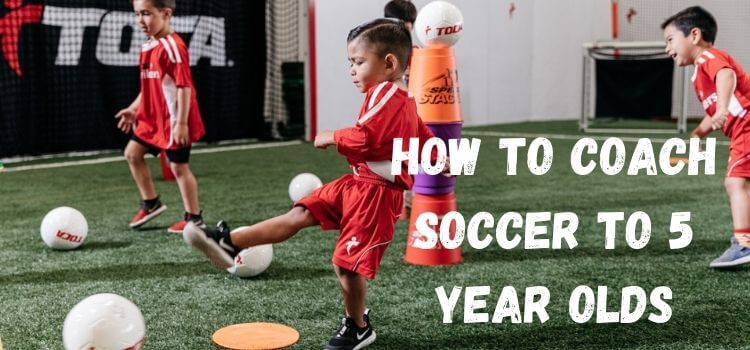As an Amazon Associate, I earn from qualifying purchases
Coaching soccer to 5-year-olds can be both a rewarding and challenging experience. At this age, kids are full of energy and curiosity but have short attention spans and varying skill and interest levels. Understanding how to approach coaching for this age group is crucial for fostering a love for the game while teaching basic soccer skills. This post aims to coach 5 year olds soccer player with helpful advice and techniques to make their practices entertaining and instructive.

Understanding 5-Year-Olds
It’s critical to comprehend the developmental stage of 5 year olds before delving into the finer points of a soccer coach. Children are developing their cognitive, physical, emotional, and social skills at this age. They are beginning to understand rules but still need plenty of encouragement and positive reinforcement.
Cognitive and Physical Development
Five-year-olds are learning to follow simple instructions and are developing their motor skills. They have a lot of energy but tire quickly, so short, varied activities work best.
Emotional and Social Development
Socially, 5-year-olds are learning to interact with peers and developing teamwork skills. They can be very enthusiastic but may need help managing emotions and frustrations.
Creating a Fun Environment
The most crucial aspect of coaching young children is ensuring a fun and engaging environment. At this age, children are more likely to enjoy and stick with soccer if they associate it with fun.
Importance of Enjoyment
If the kids are not having fun, they won’t want to return. Make sure there is laughter and joy in each session.
Techniques to Keep Sessions Fun
Incorporate games, songs, and playful activities into your training sessions. Use colourful cones and balls to keep their interest.
Basic Soccer Skills to Teach
At this age, focus on the essential skills that form the foundation of soccer. Keep instructions simple and demonstrate each skill.
Dribbling
Teach children how to control the ball with small touches. Make it fun by setting up obstacle courses.
Passing
Introduce passing by playing simple passing games. Use large, soft balls to make it easier for them to kick.
Shooting
Encourage children to aim at large, visible targets. Make it a game to see who can hit the target most often.
Basic Defending
Teach basic concepts of staying between the ball and the goal. Use fun drills to practice this.
Using Age-Appropriate Drills
Drills should be simple, engaging, and suitable for their developmental stage.
Drills for Dribbling
Set up cone mazes for kids to dribble through, encouraging them to use both feet.
Drills for Passing
Children should pass the ball back and forth between partners, progressively lengthening the distance each time.
Drills for Shooting
Create a ‘goal’ with cones and have kids take turns shooting from different spots.
Drills for Defending
Play small-sided games where kids take turns being defenders, focusing on staying before the ball.
Incorporating Games into Training
Games are a great way to teach soccer skills in a fun and less structured way.
Fun Soccer Games
Games like “Sharks and Minnows” and “Red Light and Green Light” can be used to teach dribbling and control.
Benefits of Game-Based Learning
Playing games keeps youngsters interested and teaches them soccer in a fun, organic way.
Developing Motor Skills
Motor skills are crucial for young soccer players. Incorporate exercises that develop balance, coordination, and agility.
Balance and Coordination
Use activities like hopping on one foot or balancing on a line to improve balance and coordination.
Agility Exercises
Set up agility ladders or cones for kids to run through, focusing on quick feet and direction changes.
Building Teamwork and Communication
Teamwork and communication are essential soccer skills. Encourage kids to work together and communicate on the field.
Importance of Team Play
During games and drills, emphasize the value of cooperating and supporting one another as a team.
Activities to Enhance Communication
Use games that require kids to call out each other’s names or pass the ball to specific teammates.
Positive Reinforcement Techniques
Positive reinforcement helps build confidence and encourages good behaviour.
Encouraging Good Behavior
Praise children for their efforts and achievements, no matter how small. Use a cheerful tone and be specific about what they did well.
Reward Systems
Implement simple reward systems like stickers or small treats for good behaviour and effort during practice.
Safety Considerations
Safety should always be a priority when coaching young children.
Proper Warm-Up and Cool-Down
To avoid injuries, always begin with a light warm-up and finish with a cool-down.
Ensuring Safe Play
Ensure the playing area is safe, and children wear appropriate gear, like shin guards.
Managing Expectations
Realistic goal-setting and an awareness of five-year-olds’ development are crucial.
Setting Realistic Goals
Focus on effort and participation rather than performance. Celebrate small improvements.
Understanding Progress at This Age
Acknowledge that development could be erratic and sluggish. Be patient and keep encouraging the children.
Parental Involvement
Parents are critical in their child’s soccer journey.
Role of Parents in Training
Encourage parents to be supportive and involved. Please provide them with updates on their child’s progress.
Communication with Parents
Keep an open line of communication with parents. Share successes and areas for improvement.
Handling Challenges
Coaching young children comes with its own set of challenges.
Dealing with Short Attention Spans
Keep activities short and varied to maintain interest. Use breaks and fun activities to keep energy levels up.
Addressing Behavioral Issues
Handle behavioural issues with patience and positivity. Use positive reinforcement to encourage good behaviour.
Adapting to Different Skill Levels
Children develop at different rates, so be prepared to adapt your coaching to suit varying skill levels.
Differentiated Instruction
Offer different levels of challenges within the same drill to cater to all skill levels.
Inclusive Practices
Ensure that all children feel included and valued, regardless of their skill level.
Conclusion: How to Coach Soccer to 5 Year Olds
Coaching soccer to 5-year-olds is about fostering a love for the game while teaching basic skills in a fun and supportive environment. Remember to keep sessions fun, be patient, and celebrate every small achievement. With the right approach, you can significantly impact young players, setting them up for a lifelong love of soccer.
FAQs
Basic equipment includes soccer balls, cones, small goals, and shin guards. Ensure everything is child-friendly and safe.
Keep sessions short and sweet, around 30-45 minutes. Young children have short attention spans and can tire quickly.
Try to engage them with fun games and positive encouragement. If they still aren’t interested, respecting their feelings and not forcing participation is essential.
Always have a first aid kit on hand. Administer basic first aid and inform parents immediately. Ensure the child is okay before resuming play.
Use inclusive practices and ensure that every child gets a chance to participate. Adapt activities to cater to different skill levels and encourage teamwork.
Read Our More Articles
- How Soccer Explains the World Book: An Odd Globalization Theory
- A Book About Soccer: Uncovering the Secrets of Soccer
- How to Play World Cup Soccer Drill: A Comprehensive Tutorial
As an Amazon Associate, I earn from qualifying purchases


